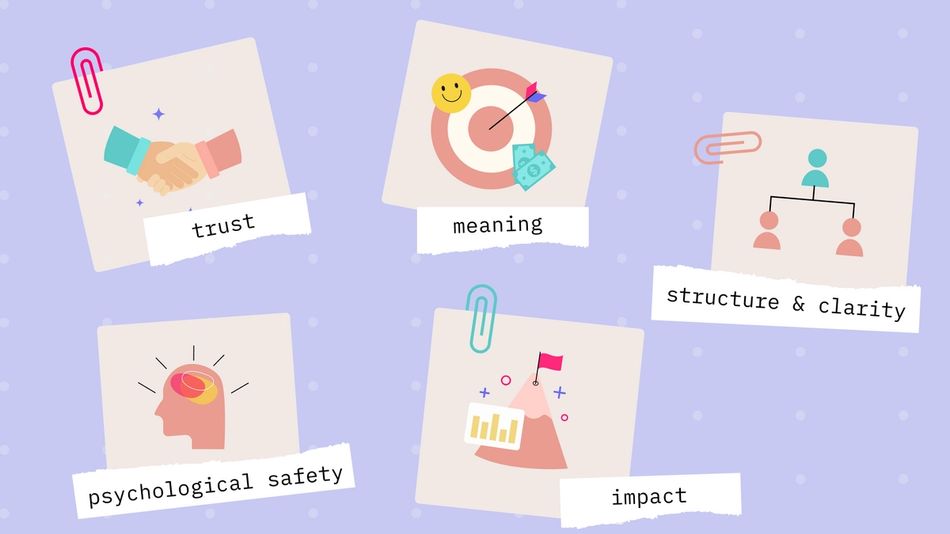
Introduction
Have you ever been on a great team?
What did it feel like?
Fun, supported, connected are common hallmarks. Impactful and valued are others. People who have been part of great teams describe a sense of trust, leading to the rewarding experience of driving through the hard work, together. It’s a good feeling, being on a highly effective team. But when you’re on an ineffective one – not so much.
Ineffective teams can make you feel unmotivated, lethargic, burnt-out, uninvolved, and like it’s just plain impossible to care less. We’ve all been there. And we don’t want to go back.
Fortunately, the effectiveness of your team isn’t set in stone. With this guide, we’ll show you how to recognize areas where your team might be struggling and unlock new ways to fuel great teamwork.
What is team effectiveness?
Team effectiveness is the capacity a team has to accomplish its goals and objectives over time. For teams to be highly effective, leaders need to create work environments and team cultures that foster and balance employee performance with well-being.
Why is team effectiveness important?
Highly effective teams are able to consistently hit their objectives. They get more done, and are more engaged in both their work and in their relationships with each other. They’re also resilient (which may not mean what you think it means — we’ll get more into that later), and have a vibrancy that positively influences their culture and the teams around them.
In their book “Teams that Work—The Seven Drivers of Effectiveness,” authors Tannenbaum and Salas tell us that effective teams benefit from the following.
- Sustained team performance: The team generates positive results over time.
- Team resilience: They work through challenges and bounce back from adversity
- Vitality: The team maintains energy, vibrancy, and resources needed for future success.
And to make sure we’re absolutely clear on the term team, we like to refer to Google’s re:work project, which does a great job differentiating a team from the concept of a “work group.” A team is a group whose members have a clear dependency on one another. They need each other to get the work done.

What is a model for team effectiveness?
Now that we know what we’re looking at, let’s dive into what we’re looking for. There are five essential components to every effective team, according to Google’s re:work.
- Psychological safety: Team members feel safe taking risks, frequently asking for feedback, and being vulnerable in front of each other. Folks comfortably admit to failure and bring up issues they may be experiencing.
- Trust: Team members can count on each other to get things done on time and meet a shared standard for excellence. Your team knows what everyone is working on and communicates about deadlines and progress.
- Structure and clarity: Team members have clear roles, plans, and goals. There's a clear process for decision-making. Every project has one owner and folks have all the information they need to do their job, which helps everyone stay accountable to commitments.
- Meaning: Team members find a sense of purpose in their work. Some examples of purpose include: financial security, supporting family, helping the team succeed, or self-expression for each individual.
- Impact: Team members believe their work matters and can create change.
NOTE: if it seems like your team could improve in some of these areas, don't worry! Fostering team effectiveness is an ongoing process, and it starts with understanding the many factors that can impact your team’s successes and working relationships. You're already on your way to better teamwork. 💪

Run an effective team
Use our Team Effectiveness check-in template to help your team know what's happening, feel more connected, and move work forward.
Shifting mindsets
Transforming ineffective teams requires a fundamental shift in day-to-day activities. Unfortunately, most companies attempting to invest in team effectiveness generally see the work as a simple add-on. A retreat, maybe, or a quarterly offsite to bring the team together. However, the impact of infrequent get-togethers like these tends to fade fast. They’re “extra”, outside of the day-to-day processes and interactions teams rely on to get work done. Bottom line: If your business-as-usual stays the same, then don’t expect to see any major changes.
If you’re planning to make a real investment in team effectiveness, it’s a good idea to shift your perspective. Building a more effective team is not just about seeing changes in team performance, collaboration, and output – though you’ll see those too. It should be first and foremost about making a positive change in employee well-being. After all, realizing organizational potential is about realizing human potential.
“While the employee experience journey may start with a focus on the workplace, perks, and rewards, in time it must focus on the more human elements of the work itself to truly create meaning.” - —Deloitte, From employee experience to human experience: Putting meaning back into work, 2019
When you see an effective team, know that there are always people working behind the scenes, figuring out the right tactics and tools to keep team performance high and foster great teamwork. We’re guessing that’s why you’re here. In the sections below, we’ll go deep on strategies you can bring back to your team.
How to create psychological safety on your team
How to create psychological safety on your team
If you feel as though your team is afraid to take risks, or has extreme reactions to uncomfortable situations, consider whether you’re creating a sense of psychological safety in your team culture.
Psychological safety means that you don’t feel that you’ll be punished or humiliated for speaking up. When people feel safe, they’re more likely to take risks, which means greater innovation for your organization. Teams feeling comfortable enough to innovate in their roles have a greater enthusiasm for work, which in turns brings about greater efficiency. But it also means feeling safe with discomfort, and making the right decision even when it’s tough.
A sense of belonging is important, especially when things go wrong. If a teammate sees something that doesn’t sit well with them, they need to feel safe enough to bring it up to the team and get everyone back on track. Otherwise, they’ll all head full speed ahead in the wrong direction.
“High belonging was linked to a whopping 56% increase in job performance, a 50% drop in turnover risk, and a 75% reduction in sick days. For a 10,000-person company, this would result in annual savings of more than $52M.” — Harvard Business Review, Dec. 2019, The Value of Belonging at WorkLearn more about building your team’s psychological safety

Ways to encourage a sense of belonging
- Build the habit of connecting during work: Make sure this is done regularly, not just during happy hours. During these moments of connection, be sure to encourage emotions and lead by example. If you’re having a bad day or distracted by something outside of work, say so. The goal is to create a safe space where anyone feels comfortable sharing what’s on their mind.
- Set aside time for team feedback and retros: Be clear that these are safe spaces for learning and growth, and that blaming and finger-pointing are not only not welcome, they detract from the actual experience.
- Take time to learn about other people, not just your direct coworkers: This one can be tricky, especially when you’re remote and can’t casually get to know each other over coffee or lunch. At Range, we’ve found that starting with a set of team-building questions can be a good way to break the ice and give people a safe way to start to get to know each other better. We put together an eBook filled with team building questions (and the psychology behind them) to help your team share authentically and in meaningful ways.
Giving and receiving feedback
Effective teams know that they always have to keep growing. This means that they need to not only be receptive to feedback, but to actively seek it out as well, taking ownership of their growth. Without a strong understanding of feedback etiquette and its benefits, a team that’s effective today won’t be able to adapt to tomorrow’s landscape. Industry, organizational, or business-level changes are guaranteed to happen, and all teams need to embrace development — and help each other in the process.
At a high level, people on effective teams approach each opportunity to offer feedback with curiosity and empathy. This helps reinforce that you’re all on the same team, with the same objective: investing in professional growth. This, in turn, helps the person receiving the feedback be more open to understanding what’s being said, and be more likely to take action.
How to build a culture of trust
If your teammates struggle to know what each other is working on or find it difficult to bring new folks into the fold, there’s probably work to be done in building trust and dependability.
On effective teams, individuals know they can count on each other to get things done. They trust each other to deliver work on time, and know that the quality of work will be high and reliable. Having a solid sense of psychological safety in place helps build this trust, as does strong team communication.
Ways to foster trust on your team
- Create a regular cadence of sharing updates: At Range, we think about team effectiveness a lot and built our Check-in tool with this in mind. It helps foster trust by improving team communication and encouraging connection. Folks can read and share daily updates and check in on how each other are doing in just a few minutes at the start of every day.
- Get to know each other: Connecting on a more personal level is a proven way to build trust. Try kicking off your team meeting or standup with a 5-minute icebreaker or team-building question. Research shows when people talk at the beginning of a meeting, they're more likely to stay engaged throughout, which is why we built the spinner tool that’s part of Range’s meeting feature.
- Practice gratitude: Getting in the habit of saying Thanks! is good for a lot of reasons–including building trust. With Range Check-ins, it’s easy to engage with your team and celebrate each other’s wins.
Folks feeling disengaged? Try working to strengthen trust.
No one wants to feel disengaged at work, nor work with someone who does. But solving for engagement can be challenging, because it’s not strictly a relationship between the employee and the work they’re responsible for. Simply swapping in one project for a slightly more exciting one isn’t likely to make much of a difference.
Engagement is really about the culture of the organization, and is rooted in trust. Knowing other folks on the team rely on (and value) your work can be a huge motivator. It helps make you feel like you’re an integral part of the team, and connected to a greater purpose.
How to empower your team with structure and clarity
If your team struggles to know who is the owner of any given project or folks complain about micromanaging, it’s time to bring more structure, clarity, and accountability into your workplace.
Give people clear ownership and create accountability
On effective teams, each project has one clear owner. That person is responsible for the success or failure of the project, and is held accountable to see it through. On ineffective teams, when ownership is vague, managers often feel the need to micromanage because there isn’t a clear owner and they’re worried about dropping the ball.
Ways to create more accountability
- Define project ownership: Take a look at all the major projects that you have going on this quarter, and review the owners for each task. Does each task have one clear, identifiable owner? If not, work with your team to define who owns what.
- Create a RACI chart for product launches: RACI is an acronym–it stands for responsible, accountable, consulted, and informed. Outlining these roles before each launch can help improve team communication and visibility, and ensure projects move forward smoothly.
- Lead by example: For team leaders, the best way to instill accountability is to start with yourself. Own up to your mistakes, and make it clear what you’re responsible for, so people know who to come to with questions on the project — and who to talk to if it goes wrong. If you find yourself on a task with shared ownership, change it. More than one owner on a task means that no one owns the task.
Create a culture of transparency
Transparency in the workplace means that people know enough, at the right time, to feel empowered to make autonomous decisions. The power of transparency, when done right, can have a tremendous impact on your team’s effectiveness. It gives folks clarity and leads to trust and autonomy, by making sure that no one person hoards all the information.
Being transparent doesn’t just mean that information is accessible though, or that people are comfortable speaking openly and asking questions. There need to be systems and processes in place that encourage effective team communication, and serve their purpose regardless of whether the teammates already consider themselves good communicators.

Ways to foster transparency
- Share daily updates and meeting notes: Establish a regular cadence of team communication, including daily progress updates. As a team leader, make sure your team has daily standups or Check-ins on the calendar and lead by example as you build the habit of sharing on a daily basis. Share meeting notes and decisions broadly to raise awareness and create alignment.
- Create a knowledge base: Build a source of truth for the team, so that they know exactly where to go for their answers, and feel empowered to update and add to it. At Range, we use the Team Directory to see the owners and chains of accountability for each project, as well as progress being made toward broader team goals.
Once you start applying some of these processes, you might find that the team will come up with other workflows to support themselves even more. A few investments into different ways of working can shine a light on how similar processes can be improved.
How to make work meaningful for your team
Helping your team find purpose or meaning in their work is central to team effectiveness. Purpose creates alignment and engagement. A common purpose fires everyone up and increases motivation to get the job done.
When team members have a sense of purpose, it creates an emotional connection between them and the mission driving their work. Purpose will look different for different folks on your team. Some people are motivated by financial or career growth. Others are motivated by helping customers or teammates, or by working towards a mission or goal that aligns with their personal beliefs.
As a manager, it’s important to understand what motivates each individual on your team, and move them towards projects that best serve that motivation.
Developing a customer-first mindset
One way to ignite a sense of purpose is by reminding your team of the end user — the customer — using your product or service. Bringing in customer stories, or the actual customer to tell their own story, can be a powerful reminder of the why behind the work But keep in mind that a one-off event won’t do the trick. Developing a customer-first mindset is a much more sustainable solution, and will encourage your team to carve out their own opportunities to get closer to customers.
Creating a collective purpose
When everyone understands where they fit into their organization, and how and where they add value, it’s easier to have a sense of purpose.
How can a team leader motivate their team? – A case study from KPMG
At KPMG, managers took purpose seriously. One motivation tactic they found most successful was to ask teams “What do you do at KPMG?” The teams wrote their responses on a poster, and leadership incentivized them to create 10,000. Then more teams wrote more responses on more posters, then even more, creating 42,000. KPMG had found a brilliant way to help employees personally identify with its collective purpose.
KPMG eventually moved up 31 spots on Fortune’s Best Places to Work, landing comfortably at #12.
For some employees, how they fit into the greater org might be absolutely clear. For others, perhaps they might understand the work that they’re doing, but have trouble seeing the value that their work adds to the business as whole.
If you feel that this might be the case on your team, try out some of the activities below.
Ways to create collective purpose and motivate your team
- Establish a team charter: Clarify why your team is working together, the principles that guide your work, and the general rules of engagement.
- Set OKRs: Align your work with purpose by setting strong OKRs or goals that outline the why in addition to the what and the how. Range links objectives to Check-in status updates using hashtags to help everyone map daily work to longer-term goals.
- Define roles: Define and share individual roles on the team to clarify who does what. At Range, we do this using the Team Directory.
A collective purpose needs to bring people together from the bottom up. In order to achieve maximum team effectiveness, each person needs to see how their role contributes to the larger goal. This begins with each team member’s personal objectives for the quarter.
Learn how Range can help you write better OKRsHow to help your team feel its impact
Knowing your work has an impact is important, and is a major differentiator for highly effective teams.
When folks feel like they’re regularly making progress towards their goals, and that their work matters, it creates momentum. People feel valued, celebrated, and motivated when they see their work is recognized. On the flipside, when accomplishments go unnoticed, team members might be frustrated or left wondering if their work actually provides any value.
Ways to help your team feel its impact
- Celebrate success: Develop a practice of recognizing folks on your team for the work they do. You might choose to spend the first 5 minutes of a team meeting doing this, or use a tool like Range to engage and react to each other’s accomplishments on a day-to-day basis. Champion projects both big and small, so everyone feels like their work is making a difference.
- Set team and individual goals: Set team OKRs and encourage folks to set personal ones too, so they can see how their individual work ladders up into the big picture.
Applying these strategies on your team
Each team functions and depends on each other in unique ways. Before you embark on making changes to lead your team toward greater effectiveness, take some time to reflect on what optimal team performance would look like for your team in particular. Remember that best practices are good — but contextual practices are even better.
And thanks for wanting to make the workplaces of tomorrow better than they are today.




